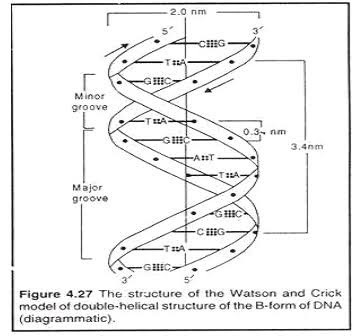The first person to give any thought to the three dimensional structure of DNA was W.T Astbury.later Rosalind Franklin(associate of Wilkins) obtained a superior X-Ray diffraction photographs of DNA.Watson and Crick when observed Franklin's picture of DNA they immediately utilized that information in constructing a molecular model for DNA.
In April 1953, they published this model.They proposed that in DNA molecule the adjacent deoxyribo_nucleotides are joined in a chain by phosphodiester bridges which link 5' carbon of the deoxyribose of one mononucleotide unit with the 3' carbon of the next mononucleotide unit.
According to them DNA molecule consists of two such polynucleotide chains wrapped helically around each other,with the sugar phosphate chain on the outside and purines and pyrimidines on the inside of the helix.The two polynucleotide strands are held together by hydrogen bonds between specific pairs of purines and pyrimidines.
These hydrogen bonds are such that adenine can bond only to thymine by two hydrogen bonds and guanine can bond only to cytosine by three hydrogen bonds and no other alternative is possible between them.This specificity of H-bonding assures that for every adenine in one chain there will be thymine in other.For every guanine in first chain there will be cytosine in other chain and so on.
Thus two chains are complementary to each other,that is,the sequence of nucleotides in one chain dictates the sequence of nucleotides in the other.The two strands run anti_parallely ,that is,have opposite directions.
One strand has phosphodiester linkage in 3'-5' direction ,while other strand has phosphodiester linkage in just reverse or 5'-3'.Further both polynucleotides strand remain separated by 20Anstron distance.The coiling of double helix is right handed and a complete turn occurs every 34 A(3.4 nm) since each nucleotide occupies 3.4 A(0.34nm) distance along the length of a polynucleotide strand, ten mononucleotides occur per compete turn .
The base pairs are rotated 36 degree with respect to each adjacent pair.The helix has two external grooves ,a deep wide one,called major groove and a shallow narrow one,called minor groove:both of these grooves are large enough to allow protein molecules to come in contact with the bases
 |
| Add caption |
Watson and Crick model, DNA three dimensional structure, DNA structure










No comments:
Post a Comment
Thank you for commenting.